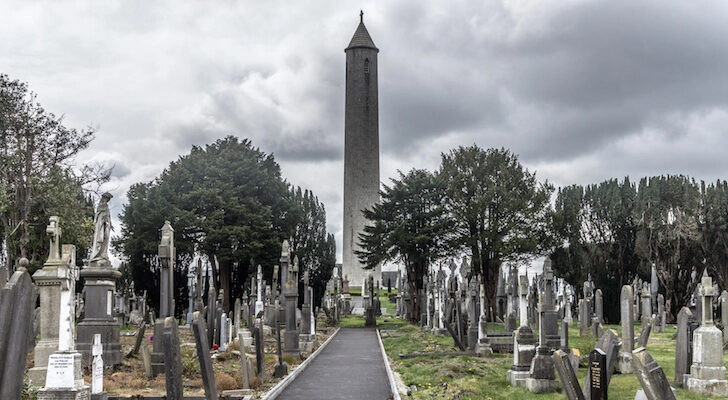So Once Was I: Forgotten Tales from Glasnevin Cemetery, by Warren Farrell
(Merrion Press, €19.99 / €16.99)
Glasnevin Cemetery is an important place, but at the same time one which is little known. How it came into existence has to be kept in mind. It arose directly out of the repeal of the Penal laws. These, as we in Ireland so often forget (or choose to ignore) were laws that affected both islands of the then United Kingdom, and not just Ireland. (We hardly apprehend here in Ireland that English Catholics also suffered under them.)
In previous centuries there were no Catholic cemeteries as such. By law Catholics had to be buried in what would now be regarded as Church of Ireland graveyards.
But the post-1829 dispensation Catholics could have their own graveyards. Dublin under the leadership of Daniel O’Connell responded by opening a National Cemetery at Glasnevin.
Edifice
In time the most important edifice in the new creation would be the memorial to Daniel O’Connell, the place where his body now lies, while his heart is symbolically in Rome. And around him the serried ranks of Catholic graves were laid out.
Comparisons are often made with the London Necropolis, and with the Catholic equivalent in London at Kensal Green. But I am more reminded by the sorts of campo morto found in Italy or France, say in Naples or Père Lachaise, though here the tombs and graves are not so extravagant.
So it was here over the decades that the great and the good of the Irish national revival over the course of the next century were interred.
In Glasnevin I found the place was often a realm of anonymity; I was more often conscious, not of the great and the good, but of the tombs of the unknown citizens”
Since 2016 author Warren Farrell has been a tour guide there. This, his first book (but surely not his last) is written in a personal capacity and benefits from it.
So much so that he feels assured enough to begin his eleven chapters, with two on ‘Strange Things’ and ‘Sport’. Eventually he does indeed work his way around top ‘Religious Figures’ and ‘Conflict, Revolution and War.’
All this is, compared with the earlier guide books, a very refreshing and human approach.
Quests
Over many long years on my various biographical quests I have spent long hours wandering around Glasnevin. But on these occasions in Glasnevin I found the place was often a realm of anonymity; I was more often conscious, not of the great and the good, but of the tombs of the unknown citizens.
For instance the grave in which John Joyce and his wife, the parents of the great writer, is well marked, and often visited by his admirers. What is not realised is that it contains a number of other Joyces, those children who died as neonates, including that other John Joyce, the first born of the family, who haunted the imagination of James himself.
Tales
For me then, while relishing all the tales that Warren Farrell tells, do indeed capture aspects of the place, it is the anonymous dead that haunt my imagination, especially ‘The Angels Plot’ and the multitudinous dead of the great Dublin cholera outbreak
Also dismaying, or so I found, was the vandalism committed by young people climbing over the cemetery boundary walls, who spend many reckless evenings overthrowing the stones and crosses that mark the graves of Dublin’s lesser known, but not quite anonymous folk. Certainly Ireland could and does neglect its dead, but desecration seems like plain wickedness.
Anyone going to visit the graves mentioned by Warren Farrell, should spend some time at least in the oldest section of the Cemetery down by the original entrance. They should also cross the road to see the extension where newer burials, rather than those of historic interest, are to be found. These sections of the cemetery are also part of the place’s story, perhaps in way the greater part of it.
This is a book to buy and read, but also to carry along when doing your own searches and researches over in these dismal acres.


 Peter Costello
Peter Costello The O’Connell Monument towers over all the other graves in Glasnevin Cemetery
The O’Connell Monument towers over all the other graves in Glasnevin Cemetery 